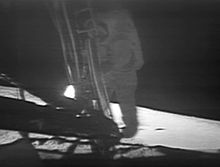Share This Page
On July 20, 1969, Neil Armstrong and Buzz Aldrin walked on the Moon, the first people ever to do so. Ever since the blastoff of Sputnik, the Soviet Union's satellite, in 1957, the United States had wanted to beat the Soviets in the Space Race. And beat them they did, in succeeding in walking on the Moon. Explorations for a landing site had been ongoing for about two years. Scouring high-resolution photographs taken by unmanned probes that had circled the Moon, scientists at the National Aeronautics and Space Administration (NASA) had narrowed down an initial list of landing sites from 30 to three. Once they had made the final cut, all systems were go. Apollo 11 was not the first American mission to orbit the Moon. That honor belonged to Apollo 8, in December 1968. That mission became well-known for the crew's reading from the Bible on Christmas Eve and for William Anders's iconic Earthrise photo. What the crew also did was test the firing systems once they had achieved lunar orbit, simulating what an eventual lunar landing mission would do, and test communications from lunar orbit, a distance of some 252,000 miles from Earth. The next mission, Apollo 9, was a full-throttle test of most of the systems that would be needed to land on the Moon. The crew, spacecraft, and systems passed with flying colors. On the fifth day of the 10-day mission in March 1969, Jim McDivitt and Rusty Schweikart climbed into the lunar module and flew it more than 100 miles away from the command module. In a rehearsal for what astronauts who had walked on the Moon would later do, the lunar module crew then enticed their spacecraft to "rise" again, and they docked safely with Dave Scott in the command module. Two months later, Apollo 10 launched and did everything that the Apollo 11 crew would eventually do except land on the lunar surface. In the most critical test yet, Gene Cernan and Thomas Stafford climbed into the Lunar Module and descended to less than 47,000 feet above the Moon. They made two passes over what would become the Sea of Tranquillity landing site for their successors, tested all manner of systems–attitude control, communications, propulsion, and radar–and then successfully rejoined John Young in the Command Module. The stage was set. Collins had designed the Apollo 11 mission emblem, choosing the bald eagle as the symbol after a suggestion by fellow astronaut Jim Lovell and the olive branch after a suggestion from simulator instructor Tom Wilson. The crew together decided not to put their names on the emblem, as had previous crews, in order to emphasize that it had been a total team effort. The crew had named the Lunar Module Eagle, referencing the one in the emblem that Collins had designed. For the Command Module, they chose the name Columbia, evoking memories of Christopher Columbus and Columbia, the name of the giant cannon that launched the spacecraft in Jules Verne's novel From the Earth to the Moon. Armstrong and Aldrin, in Eagle, had a nervous moment just before touchdown. Once they were nearly on top of the landing site, they discovered that it had too many boulders for their liking. Armstrong took over manual control and steered the spacecraft a bit further on, to a more preferred landing spot. They reached the surface with their fuel nearly gone. The Eagle, as the Lunar Module was known, touched down at 4:17 p.m. Eastern Time. But the crew didn't leave the spacecraft right away. They spent two hours going through an extensive systems check, making sure that all was go for the intended stay on the surface. They also had a bite to eat. The schedule of events as set out by NASA then called for them to rest for another four hours, on the theory that they would have been tired from the flight so far. Adrenaline won out over scheduling, and Armstrong descended the ladder at 11:56 p.m., setting foot on another world for the first time in human history. His now famous first words were, "That's one small step for man one giant leap for mankind." Twenty minutes later, Aldrin joined Armstrong on the lunar surface. An exterior camera had captured Armstrong's descent and first footsteps and beamed them back to Earth in real time, to an audience that has been estimated at 650 million people. The same was true for Aldrin, who had the added benefit of being photographed by Armstrong. In fact, most still photographs of the pair on the Moon are of Aldrin for the simple reason that Armstrong was the mission photographer and so was holding the camera most of the time. Perhaps the most famous photo of this first landing on the Moon is the shot of Aldrin, with his visor showing a reflection of Armstrong. Armstrong and Aldrin were on the lunar surface for less than three hours. During that time, once they had spoken to President Richard Nixon in a live broadcast, they got down to business, conducting samples of lunar soil, rocks, and crust. They erected a flagpole holding the U.S. flag and left a plaque that read
The endeavor was a scientific one as well, in essence an exploration of Earth's only satellite with an eye toward a better understanding of how and why Earth is the way it is. Armstrong and Aldrin didn't stay put. They covered a distance of more than 3,300 feet in all, lumbering along in their heavy spacesuits but, because of the gravity being one-sixth of Earth's, reported travel on the lunar surface easier than everyone thought it was going to be. They brought back more than 47 pounds of moon rocks in all. 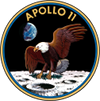
Including time inside the capsule, the lunar module crew spent nearly 22 hours on the Moon. Honoring NASA's request for a rest period before they resumed their journey, the Lunar Module crew slept for seven hours before leaving the lunar surface. True to form, the astronauts found an incredibly simple solution to a seemingly unsurmountable problem. Aldrin had accidentally brushed up against the circuit breaker tasked with arming the main engine for liftoff. The damage was such that no one was sure whether the engine would indeed fire; it was a very real possibility that Armstrong and Aldrin would be stranded on the Moon. The solution came in the form of a felt tip pen, which was sufficient for activating the switch. When it was time, the engine fired, Eagle ascended, and the spacecraft left the lunar surface. They successfully rendezvoused with Collins in Columbia, the command module, and made their way back to Earth, making two more TV broadcasts along the way and then splashing down safely in the Pacific Ocean on July 24. They spent 21 days in quarantine before moving to Houston. They were celebrated nationwide and worldwide, attending many state dinners and being the main celebrants in parades attended by hundreds of thousands of people. The first of six moon landings, Apollo 11 set the tone for future expeditions by excavating rocks and dust from the Moon's surface and testing the effects of less-than-Earth gravity on such things as men and machines. The expedition was a huge hit, sparking interest in space exploration around the world. |
|
Social Studies for Kids
copyright 2002–2025
David White



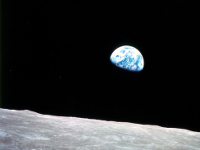
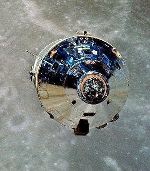
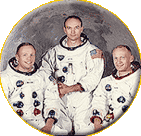 After 10 missions, getting ever closer to the landing, NASA launched Apollo 11 on July 16. An audience of an estimated 1 million people crowded the larger vicinity of the launch site. The crew turned their interior broadcast cameras on twice in the first three days of the mission, beaming back to Earth the various things that they were doing in anticipation of landing on the Moon. Their third pre-landing broadcast showed pictures of the lunar surface and illustrated their flight path. Four days later, first Armstrong and then Aldrin set foot on the Moon.
After 10 missions, getting ever closer to the landing, NASA launched Apollo 11 on July 16. An audience of an estimated 1 million people crowded the larger vicinity of the launch site. The crew turned their interior broadcast cameras on twice in the first three days of the mission, beaming back to Earth the various things that they were doing in anticipation of landing on the Moon. Their third pre-landing broadcast showed pictures of the lunar surface and illustrated their flight path. Four days later, first Armstrong and then Aldrin set foot on the Moon. 